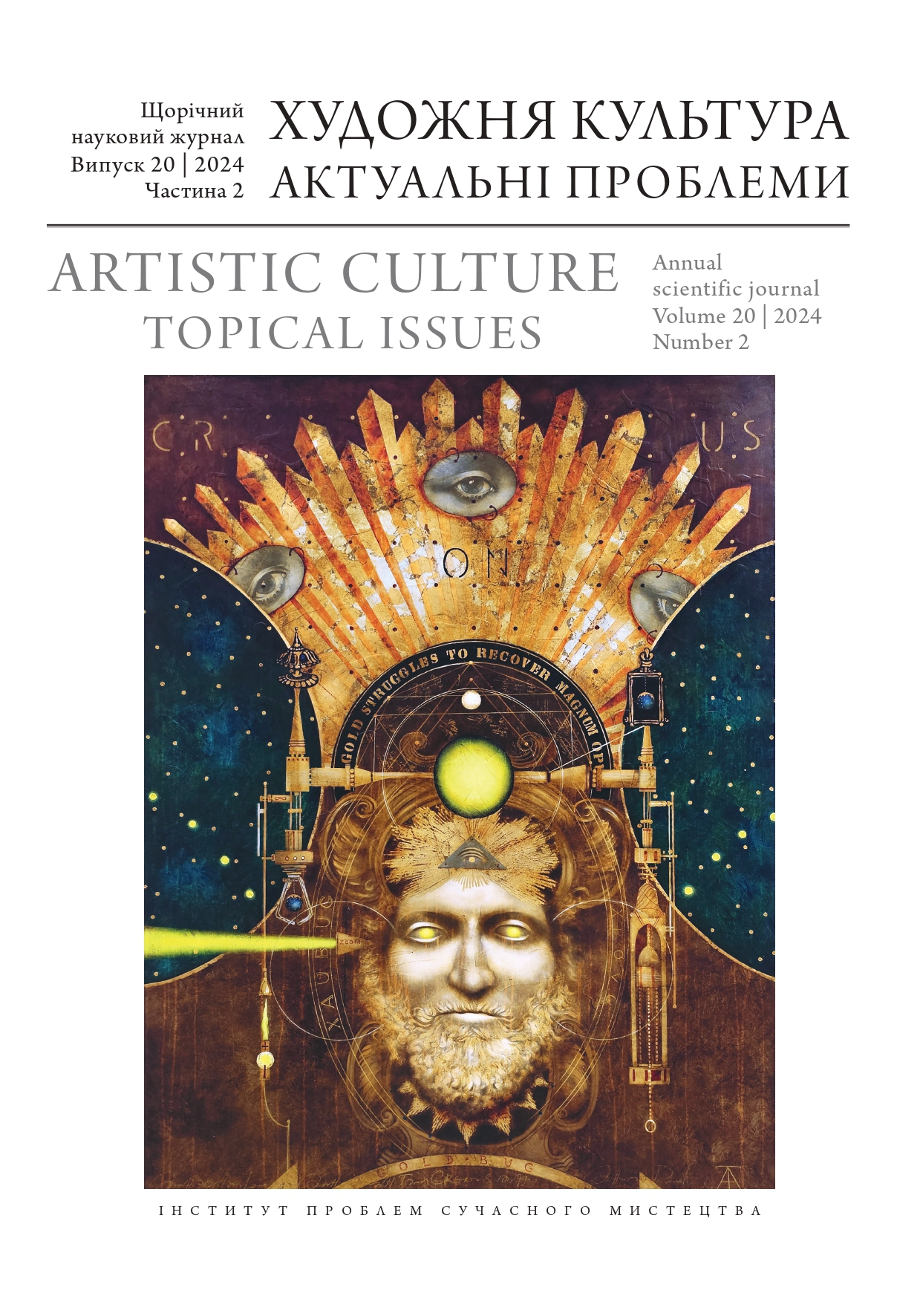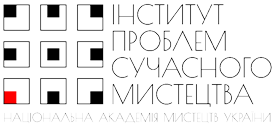Художня культура після війни: аналітичний шкіц
DOI:
https://doi.org/10.31500/1992-5514.20(2).2024.318253Ключові слова:
художня культура, повоєнна розбудова України, кордоцентризм, краса як міра, трансцендування почуттів, тероризм, диз’юнктивний синтез нігілізмівАнотація
З настанням завершальної фази російсько-української війни художня культура України більш предметно фокусується на прогностиці траєкторій повоєнного розвитку країни, головну увагу зосереджуючи на соціополітичному і пов’язаному з ним соціокультурному аспектах стратагеми майбутнього. Оскільки футурологічні проєкції потребують прискіпливого засвоєння уроків історичного минулого, автори, використовуючи загальнонауковий компаративістський метод, вивчають коло проблем, що вже тепер вимагає адекватної рефлексії соціуму, зокрема української художньої культури, від чого залежить її сутнісна якість та успішність самореалізації України як «європейської екологічної нації». Йдеться про подолання вад застарілих ідеологем постполітики і постгуманізму, що прискорили катастрофічний регрес постмодерної свідомості; актуалізацію архетипального патерну кордоцентризму; трансформації травматичної «культури страху» у витончену культуру естетичного судження, де трансцендентна істина краси править за міру цивілізованості нації, самоідентифікація якої стабілізує соціополітичне буття, зокрема через становлення «демократії почуттів».
Посилання
Badiou, A. (2005). Infinite Thought. London: Continuum. Moser, C. (2000, September 8–16). The Knowledge Society: Changing the Shape of Education for the 21st Century. In Conference Descriptions 1988–2007. Klingenthal Castle. No. 44 (3). Retrieved from https://www.21stcenturytrust.org/archive/previous-trust-conferences-and-senior-fellows/2000
Shkepu, M. (2024). Aesthetics of Pure Negativity. Article Two. The Subjectivity in the Shagreen Skin. Artistic Culture. Topical Issues, 20(1), 161–169. DOI: 10.31500/1992-5514.20(1).2024.306926 [in Ukrainian].
The Paris Statement: A Europe We Can Believe In. (2017, October 7). Retrieved from https://thetrueeurope.eu/a-europe-wecan-believe-in/
Jung, C. G. (1969). The Collected Works. Vol. 9. Рart 1. The Archetypes and the Collective Unconscious. Eds. H. Read, M. Fordham, G. Adler & W. McGuire. New York: Princeton University Press.
Kattelman, B. A. (2009). Carnographic Culture: America and the Rise of the Torture Porn Film. In S. Hill & S. Smith (Eds.), There Be Dragons Out There: Confronting Fear, Horror and Terror (pp. 3–10). Oxford, United Kingdom: Inter-Disciplinary Press.
Bosenko, A. (2005). Vremya strastey chelovecheskykh: Naprasnaya knyha [Time of Human Passions: A Vain Book]. Kyiv: Publishing house A+C [in Russian].
Taskale, A. R. (2009). Clash of Nihilisms. In S. Hill & S. Smith (Eds.), There Be Dragons Out There: Confronting Fear, Horror and Terror (pp. 47–62). Oxford, United Kingdom: Inter-Disciplinary Press.
Enzensberger, H. M. (2005, December 1). The Radical Loser. signandsight.com. Retrieved from http://www.signandsight.com/features/493.html
Judt, T. (2023). Pislya viyny. Istoriya Yevropy vid 1945 roku [Postwar: A History of Europe Since 1945]. Trans. K. Zarembo. Kyiv: Nash format [in Ukrainian].
Kornu, K. (2022, September). Transfiguration, not Transhumanism: Suffering as Human Enhancement. The Heythrop Journal, 63(5), 926–939. DOI: 10.1111/heyj.14129
Žižek, S. (2002). Hallucination As Ideology In Cinema. Theory & Event, 6 (1). DOI: 10.1353/tae.2002.0013
Agamben, G. & Emcke, C. (2001). Security and Terror. Theory & Event, 5 (4). DOI: 10.1353/tae.2001.0030
Latour B. (2022). Is Europe’s Soil Changing Beneath Our Feet? War Ecology: A New Paradigm, 2: Géopolitique, Réseau, Énergie, Environnement, Nature. Retrieved from https://geopolitique.eu/en/articles/is-europes-soil-changing-beneath-our-feet/
Dollimore, J. (2003). Art in Time of War: Towards a Contemporary Aesthetic. In J. J. Joughin, & S. Malpas (Eds.), The New Aestheticism (pp. 36–50). Manchester, UK; York, USA: Manchester University Press.
Rogotchenko, S. (2024). Art Therapy of the Ukrainian War. History. Beginning. Artistic Culture. Topical Issues, 20 (1), 97–103. DOI: 10.31500/1992–5514.20(1).2024.306918 [in Ukrainian].
Protas, M., Bulavina, N., & Isychenko, I. (2023). Between Aesthetics and Imagination: The Ongoing Transformations of Ukrainian Art in the Times of the War. American Journal of Art and Design, 8 (2), 37–45. DOI: 10.11648/j.ajad.20230802.14
Protas, M., Bulavina, N. (2023, September). Cultural Habitus of Art: The Aletheia of Self-Identification Versus the Posttruth of Postmodernity. American Journal of Art and Design, 8 (3), 87–98. DOI: 10.11648/j.ajad.20230803.12
Himmelfarb, G. (1997). Beyond Method. In A. Kernan (Ed.), What’s Happened to the Humanities? (pp. 143–161). Princeton University Press.
Lasch, C. (1984, November). The Politics of Nostalgia: Losing History in the Mists of Ideology. Harper’s Magazine, 269 (1614), 65–70.
Tannock, S. (1995). Nostalgia Critique. Cultural Studies, 9 (3), 453–464.
Quill, L. (2024). Nostalgia and Political Theory. New York: Routledge. DOI: 10.4324/9781003292869-1
Huntington, S. (1996). The Clash of Civilizations and the Remaking of World Order. New York, NY: Simon & Schuster.
Conrad, P. (2002, September 7). The Presumption of Art. Can Writers, Playwrights and Singers Help Us Come to Terms With 11 September? The Guardian. Retrieved from https://www.theguardian.com/world/2002/sep/08/september11.georgebush
Debord, G. (1994). Society of the Spectacle. Trans. D. Nicholson-Smith. New York: Zone Books. Isychenko, I., Protas, M., Mironova, T., Bokotey, M., & Bulavina, N. (2024, April). Public Sculpture in Wartime Ukraine as a Form of the State’s Memory Politics. AD ALTA: Journal of Interdisciplinary Research, 4 (1), 29–34. DOI: 10.33543/j.140141.2934
Protas, M., Isychenko, I. (2023). Contemporary Sculptural Haptics in Sociocultural Context. American Journal of Art and Design, 8 (4), 99–106. DOI: 10.11648/j.ajad.20230804.11
Assmann, A. (2006). Memory, Individual and Collective. In R. E. Goodin & C. Tilly (Eds.), The Oxford Handbook of Contextual Political Analysis (pp. 210–224). Oxford: Oxford University Press.
Benjamin, А. (2003). Including Transformation: Notes on the Art of the Contemporary. In J. J. Joughin & S. Malpas (Eds.), The New Aestheticism (pp. 208–217). Manchester, UK; York, USA: Manchester University Press.
Joughin, J. J. & Malpas, S. (Eds.). (2003). The New Aestheticism. Manchester, UK; York, USA: Manchester University Press.
##submission.downloads##
Опубліковано
Як цитувати
Номер
Розділ
Ліцензія

Ця робота ліцензується відповідно до Creative Commons Attribution-NonCommercial-ShareAlike 4.0 International License.
Автори, які публікуються у цьому журналі, погоджуються з наступними умовами:
1. Автори залишають за собою право на авторство своєї роботи та передають журналу право першої публікації цієї роботи на умовах ліцензії Creative Commons Attribution License, котра дозволяє іншим особам вільно розповсюджувати опубліковану роботу з обов'язковим посиланням на авторів оригінальної роботи та першу публікацію роботи у цьому журналі.
2. Автори мають право укладати самостійні додаткові угоди щодо неексклюзивного розповсюдження роботи у тому вигляді, в якому вона була опублікована цим журналом (наприклад, розміщувати роботу в електронному сховищі установи або публікувати у складі монографії), за умови збереження посилання на першу публікацію роботи у цьому журналі.
3. Політика журналу дозволяє і заохочує розміщення авторами в мережі Інтернет (наприклад, у сховищах установ або на особистих веб-сайтах) рукопису роботи, як до подання цього рукопису до редакції, так і під час його редакційного опрацювання, оскільки це сприяє виникненню продуктивної наукової дискусії та позитивно позначається на оперативності та динаміці цитування опублікованої роботи (див. The Effect of Open Access.


